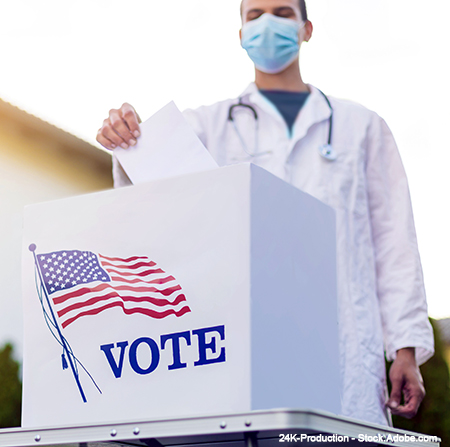 Voting is now widely considered to be a social determinant of health, with increased access associated with improved health outcomes.1,2 Nationwide, the healthiest counties have up to 30% greater voter turnout compared to the least healthy counties.3
Voting is now widely considered to be a social determinant of health, with increased access associated with improved health outcomes.1,2 Nationwide, the healthiest counties have up to 30% greater voter turnout compared to the least healthy counties.3
Already numerous medical organizations have advocated in support of healthcare-driven initiatives to increase voter engagement.4–6 Most recently, the American College of Physicians released a position paper in December 2023 promoting awareness, engagement, and recommendations in support of equitable access to the electoral process.7 The legal precedent for healthcare institutions offering voting-related material dates back to the birth of the 1993 National Voter Registration Act, permitting all offices that provide public assistance to offer voting registration opportunities.8 This stance is further underscored by the Office of Internal Revenue Services, and the Department of Health and Human Services, which support nonpartisan voter registration efforts by health centers and 501(c)(3) organizations.9,10
Yet, despite the evidence, calls to action, and legal precedent, not all hospitals have been early adopters. Some institutions may have concerns that voter engagement can be a partisan act, evolving into discussions of how individuals vote. The political and social climate has made conversations surrounding voter engagement feel polarizing, even when done in a nonpartisan manner. Institutions may lack an accepted blueprint on how to integrate voter engagement effectively and equitably into a hospital system, and some physicians may ask “Is this in our lane?” These hesitations can give rise to unintended restrictions in patient care and create a taboo, akin to early conversations surrounding firearm safety in healthcare.
Hospitalists can capitalize on their system-wide influence to help normalize voter engagement in healthcare and create sustainable and effective voter engagement solutions by: strategically engaging hospital leadership; partnering with nonpartisan civic engagement organizations; understanding hospital policy to guarantee it reflects federal, state, and local regulations; and building multidisciplinary coalitions that include learners to ensure future physicians feel comfortable and competent helping patients register to vote. Hospitalists can be the advocates that help hospital leadership embrace voter engagement in healthcare while spreading awareness that voting is a right and a determinant of health that all patients should enjoy.
At the University of Cincinnati Medical Center, hospitalists, with the support of government relations, have taken steps towards this approach. We created a partnership with Vot-ER, a nonprofit nonpartisan organization to integrate civic engagement tools into our healthcare space.11 The tools target healthcare associates to check their registration status, register to vote, or obtain additional information about voting. Through this initiative, 80% of individuals who engaged with the resources registered to vote, yielding more than 500 new voter registrations in seven months. Our partnership has expanded to include social work, hospital trainees, and other non-clinical leadership from the departments of marketing and communication, legal, and human resources. Together, we are working towards ensuring our institutional policies and practices for voter engagement effectively reach patient care.
Helping our communities get registered to vote through healthcare-driven initiatives is feasible and can lead to greater voter engagement.12,13 Hospitals must be cognizant that they serve a diverse community with varying barriers to voting. On one hand, the community of patients they care for is at a higher risk of missing out on opportunities to get registered to vote, update their registration status, and participate in the voting process when they encounter an unexpected hospitalization. On the other hand, the community they employ and medical residents they train frequently cite being too busy to register to vote.14,15 Integrating voter registration access into a hospital system can help facilitate voter engagement across a community.
With a general election on the horizon, hospital leaders have an opportunity to partner and create time-sensitive change. Hospitalists are uniquely positioned to be the catalyst for this change by leveraging their influence to help effectively integrate voter engagement into hospital systems. The time is now to create sustainable practices in our hospital systems to decrease barriers to voter engagement. As leaders in the healthcare space, hospitalists can change the narrative, and more importantly, change health outcomes by offering communities the most basic of prescriptions-the opportunity to vote.
We thank Dr. Benjamin Kinnear for his support in the aforementioned voter engagement work and in revising this article. We also thank the members of the UC Health Government Relations, Civic Health Committee, and Vot-ER leadership for helping to build our voter engagement efforts.

Dr. Rubiano

Dr. Schoenberger
Dr. Rubiano is an academic hospitalist and assistant professor of clinical medicine at the University of Cincinnati Medical Center in Cincinnati. He is also a graduate of the 2022 Vot-ER Civic Health Fellowship class. Dr. Schoenberger is a fourth-year internal medicine-pediatrics resident at the University of Cincinnati Medical Center and Cincinnati Children’s Hospital Medical Center in Cincinnati. She is also a graduate of the 2023 Vot-ER Civic Health Fellowship class.
Read more on physicians voting in the Journal of Hospital Medicine’s article, Leadership & professional development: #LeadTheVote: Practical steps to encourage physicians to vote.
References
- U.S. Department of Health and Human Services. Healthy People 2030. Https://Health.Gov/Healthypeople. Published April 29, 2024. Accessed July 5, 2024.
- U.S. Department of Health and Human Services. Health & Democracy Index: Social and Community Context. U.S. Office of Disease Prevention and Health Promotion website. https://democracyindex.hdhp.us/. Accessed June 12, 2024.
- Blomberg E, Gennuso K, et al. 2023 County Health Rankings National Findings Report | County Health Rankings & Roadmaps. University of Wisconsin Population Health Institute website. https://www.countyhealthrankings.org/findings-and-insights/2023-county-health-rankings-national-findings-report. Published 2024. Accessed July 6, 2024.
- American Medical Association. Support for Safe and Equitable Access to Voting H-440.805. AMA website. https://policysearch.ama-assn.org/policyfinder/detail/voting?uri=%2FAMADoc%2FHOD.xml-h-440.805.xml. Published 2022. Accessed July 6, 2024.
- Association of American Medical Colleges. Center For Health Justice: Fact Sheet for Nonpartisan Voter Registration at Health Care Institutions. AAMC website. https://www.aamchealthjustice.org/resources/voter-fact-sheet. Accessed July 6, 2024.
- SHM Public Policy Committee. Hospital medicine, it’s time to vote. The Hospitalist website. https://www.the-hospitalist.org/hospitalist/article/229706/mixed-topics/hospital-medicine-its-time-vote. Published October 8, 2020. Accessed July 6, 2024.
- Cline K, Hilden D, et al. Ensuring equitable access to participation in the electoral process: a policy brief from the American college of physicians. Ann Int Med. 2024;177(1):68-9. doi: 10.7326/M23-2293.
- U.S. Department of Justice. Civil Rights Division: About The National Voter Registration Act. DOJ website. https://www.justice.gov/crt/about-national-voter-registration-act. Updated April 5, 2023. Accessed July 6, 2024.
- Internal Revenue Service. Frequently Asked Questions About the Ban on Political Campaign Intervention by 501(c)(3) Organizations: Get-Out-the-Vote Activities. IRS website. https://www.irs.gov/charities-non-profits/charitable-organizations/frequently-asked-questions-about-the-ban-on-political-campaign-intervention-by-501c3-organizations-get-out-the-vote-activities. Updated March 1, 2024. Accessed July 6, 2024.
- U.S. Health Resources & Services Administration. Voter Registration and Health Centers. HRSA Health Center Program website. https://bphc.hrsa.gov/compliance/scope-project/voter-requirements. Updated March 2022. Accessed July 6, 2024.
- Vot-ER. Healthy Communities Powered By A Healthy Democracy. Vot-ER website. https://vot-er.org/. Accessed July 6, 2024.
- Liggett A, Sharma M, et al. Results of a voter registration project at 2 family medicine residency clinics in the Bronx, New York. Ann Fam Med. 2014;12(5):466-9.
- Lickiss S, Lowery L, et al. Voter registration and engagement in an adolescent and young adult primary care clinic. J Adolesc Health. 2020;66(6):747-9.
- Ahmed A, Chouairi F, et al. Analysis of reported voting behaviors of US physicians, 2000-2020. JAMA Netw Open. 2022;5(1):e2142527. doi:10.1001/jamanetworkopen.2021.42527
- Lalani HS, Hong AS, Siddiqui R. Barriers to voting in 2020 among resident physicians. J Gen Intern Med. 2021;36(1):254-5.